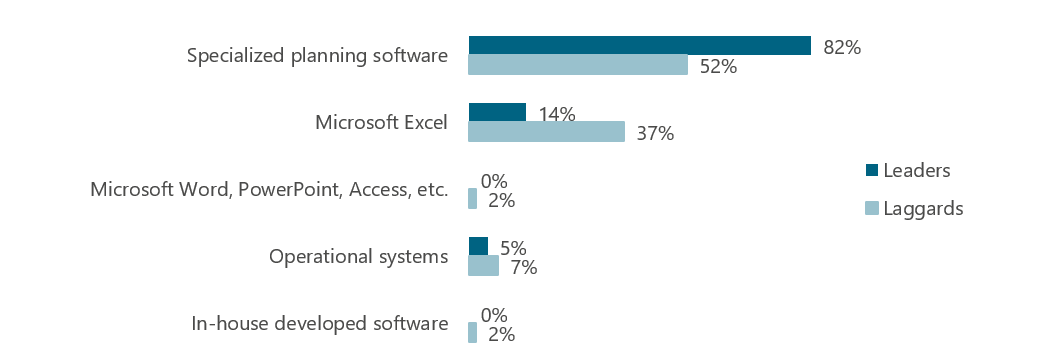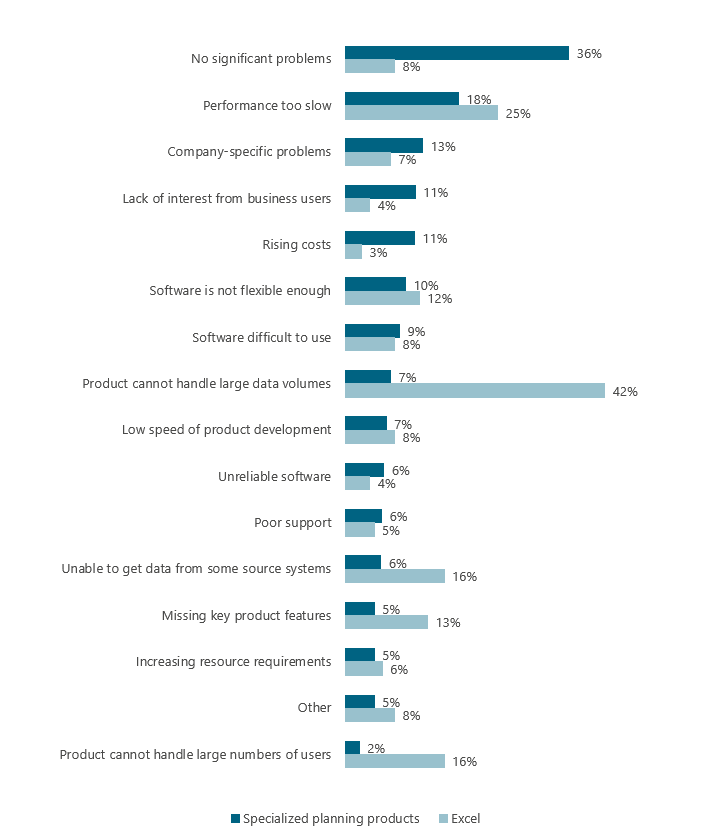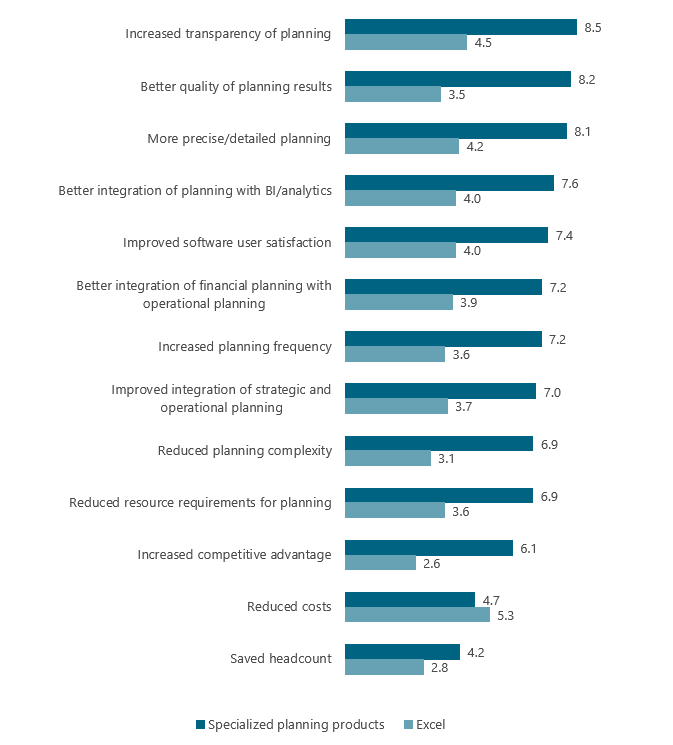Excel vs. Specialized Planning Software: Making the Right Choice
Planning, budgeting and forecasting are central pillars of corporate management. In particular, planning has the task of setting goals, defining measures to achieve them and optimizing the use of available resources.
Within corporate planning, forecasting and scenario planning have gained massively in importance in recent years. The dynamics of markets and competition as well as events such as the pandemic, the Russia-Ukraine war and the resulting economic uncertainty have led many companies to realize that they need to invest in corporate planning and the preparation of forecasts. This applies above all to better technological support, but also to further development in terms of processes and content.
8 out of 10 companies still use Excel for planning, budgeting and forecasting
The reality in many companies is that the use of Microsoft Excel to support planning processes is still surprisingly high. Year after year, BARC’s annual global survey of planning professionals “The Planning Survey” shows that the percentage of those using Excel for planning – separately or in combination with other tools – is still well above 70 percent (see Figure 1). Excel is thus a significant part of the planning process in almost 8 out of 10 companies, especially in laggard companies. To examine correlations between what the most successful companies do differently to less successful ones, the BARC Planning Survey classifies companies as 'leaders' and 'laggards'. Laggards' comprise the lowest 10 percent (approx.) of companies based on their achievement of business benefits.

The comparison of leaders and laggards in Figure 2 reveals that 82 percent of leaders use specialized planning software for planning, budgeting and forecasting, whereas 37 percent of laggards standardize on Excel. Just 52 percent of laggards use specialized software as their main planning product. Something we often discover in BARC’s consulting projects is that a company’s choice of software for planning often reflects its level of appreciation of the value of planning. While planning, budgeting and forecasting are important elements of corporate management to align operational business with strategic corporate objectives for many leaders, it is often regarded by laggards as a chore that has to be done at least once a year.

Only 8 percent of users have no problems when using Excel for planning
Considering the importance of planning, budgeting and forecasting for corporate management, such extensive use of Excel is surprising, but it casts a different light on many of the challenges that exist in planning processes today and makes them easier to understand. In many organizations, planning processes are not integrated enough, take too long, tie up too many resources, are too detailed, and the quality of the results – measured against the effort invested – is often not well balanced.
Figure 3 offers evidence that Excel users experience many more problems than users of specialized planning software products such as Financial Planning and Analysis from Prophix. Only 8 percent of Excel users say they have no significant problems at all, compared to 36 percent of specialized planning software users. Moreover, Excel users struggle with general problems such as ‘product cannot handle large data volumes’ (42 percent), ‘performance too slow’ (25 percent) and ‘product cannot handle large numbers of users’ (16 percent).

Not least because of the advantages cited above, specialized planning products have a much higher recommendation rate for planning purposes than Excel. While 85 percent of users of specialized planning software say they would “probably” or “definitely” recommend their planning product to other companies, only 45 percent of Excel users say the same. Indeed, 29 percent of Excel users state they would “probably not” or “definitely not” recommend the use of Excel as a planning tool to other companies (see Figure 4).

Business benefits from specialized planning products vs. Excel
Solutions for planning, budgeting and forecasting support the complete process, from model building and the definition of planning masks and workflows to the execution of planning and analysis of plans. The following benefits and added values are most frequently achieved by organizations using specialized planning software products from Prophix such as:
- Increased transparency of planning
- Better quality of planning results
- More precise/detailed planning
- Better integration of planning with BI/analytics
- Improved software user satisfaction
Figure 5 shows clearly that companies using specialized planning products achieve a far higher level of business benefits than companies using Excel as their main planning tool, proving that Excel is not entirely suitable as a planning product. Notably, the top benefits of specialized planning products are much less likely to be achieved with Excel. Except for a reduction in costs, the use of Excel for planning is inferior in every business benefit. However, even a reduction in costs (primarily license costs) is "paid for" through a greater manual workload and potential error corrections.

How modern software platforms support planning, budgeting and forecasting
The use of specialized planning products such as Financial Planning and Analysis from Prophix instead of Excel is a decisive factor in the success of efficient corporate planning. These tools offer extensive support functions for the preparation, execution and analysis of planning.
The basis of integrated corporate planning is a uniform database for actual and plan data as well as a consistent data model. Market-leading software tools for corporate planning support the central storage of all data and thus create a single, common data basis for corporate planning as well as for other performance management disciplines such as reporting, analysis and financial consolidation (single point of truth).
Based on this, an integrated model for corporate planning must be developed. The aim is to flexibly integrate strategic and operational planning with financial and results planning. In particular, this includes the integration of all operational sub-plans (sales, production, procurement, resources, costs, investments, etc.) including their integration with the financial plans (balance sheet, P&L, cash flow).
Corporate planning tools support different planning strategies such as top-down and bottom-up planning. Top-down approaches are mainly used for strategic business planning and results planning. Bottom-up approaches, on the other hand, are more often used in distributed environments where the aim is to collect plan data from a large number of decentralized planners. Whereas top-down planning often requires functions for simulation with scenario analyses or data distribution ("splashing"), for bottom-up planning, user-friendly functions for plan data entry via various clients (Web, Excel, etc.) as well as workflow mechanisms for process control are helpful.
Since planning requirements can change quickly due to increasing dynamics, many business departments strive to increase flexibility in handling data and independence from central IT (self-service). For this reason, software tools must allow simple, business-user-friendly operation without requiring a great deal of training in order to achieve fast results. If a solution is available in the cloud and is operated by the software provider (software-as-a-service), this additionally reduces dependence on the company's own IT resources.
Summary
The dynamics of market and competition constantly pose new challenges for companies. Within corporate management, corporate planning has the task of setting goals, defining measures to achieve them and optimizing the use of available resources. Hereby, the use of specialized planning products is a decisive factor for effectiveness and efficiency.
The reality in many companies is that the use of Microsoft Excel for planning is still surprisingly high, which is a risky approach. To answer the question from the title of the blog, no, using Excel for planning processes is not a good choice. Not only because Excel users experience many more problems than users of specialized planning software products, but also because Excel lacks functionality and support for streamlining planning processes.
Modern market-leading financial performance management platforms such as Prophix offer extensive support functions for the preparation, execution and analysis of planning. To achieve the best possible support for a company's processes, planning tools must be carefully selected according to its particular requirements. A formalized software selection process with a comparative consideration of several solutions is important and creates investment security.
This blog post was written in collaboration with BARC.
Dr. Christian Fuchs is Senior Analyst and Head of Data & Analytics Research at BARC (Business Application Research Center). He specializes in decision-support systems in the areas of corporate performance management, corporate planning, financial consolidation and analytics. He is the author of numerous BARC studies. As a consultant, he supports organizations in the software selection process as well as in strategic questions regarding the software portfolio, architecture and usage scenarios.
